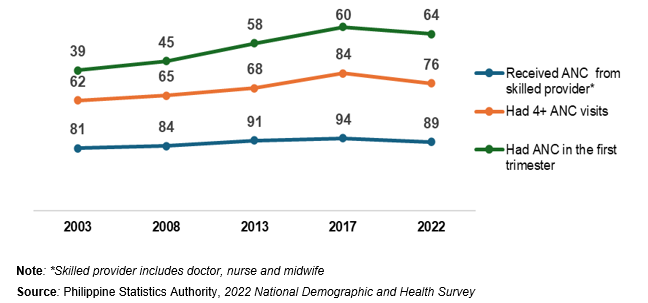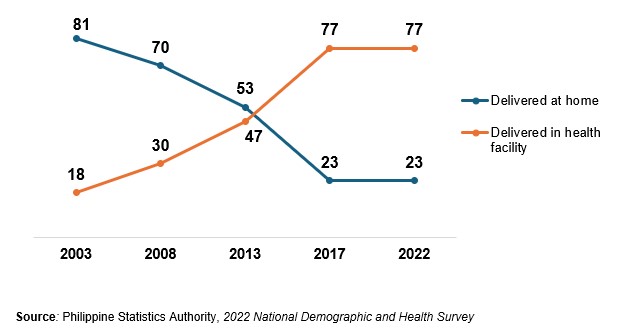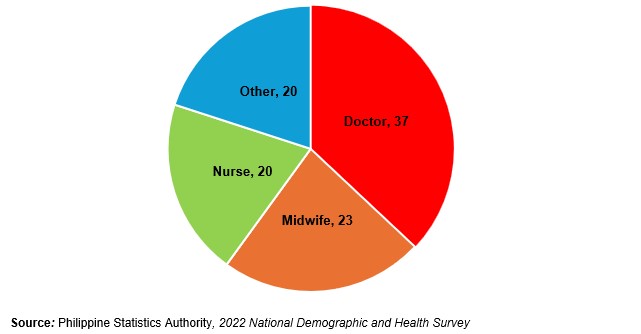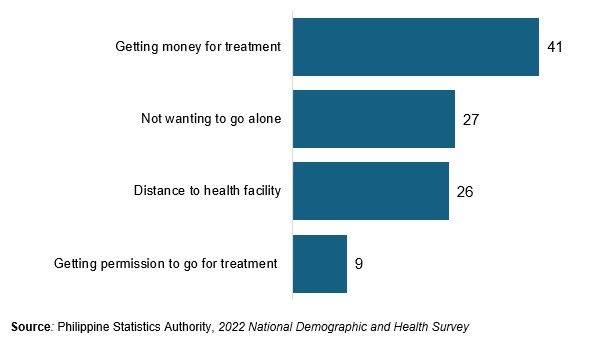Nine in ten women received antenatal care from a skilled provider
Health care services during pregnancy, childbirth and after delivery are important for the survival and well-being of both the mother and the infant. Antenatal care is a preventive health care provided by health care professionals to pregnant women to prevent complications during pregnancy and even maternal and child deaths.
The percentage of women in MIMAROPA region with a live birth in the two years preceding the survey who received antenatal care from a skilled provider increased from 81 percent in 2003 to a peak of 94 percent in 2017 before decreasing to 89 percent in 2022. Percentage of women with a live birth who had antenatal care in the first trimester increased from 39 percent in 2003 to 64 percent in 2022. (Figure1)
Figure 1. Trends in Antenatal Care (ANC) Coverage, MIMAROPA: 2022

The top three ANC providers are midwife (47%), doctor (36%) and nurse (6%). Among women 15-49 years old in the MIMAROPA Region with ANC, more than half or 53 percent with a live birth and/or stillbirth in the past two years had four to seven ANC visits. Women who were pregnant of more than four months or 64 percent had their first ANC visit.
More than three in every four childbirths were delivered in a health facility
Giving birth at a hospital with skilled assistance reduces the risk of compromising women’s health as well as that of their newborns, In the MIMAROPA Region, health facility-based deliveries rapidly increased over the past two decades, from 18 percent of live births in 2003 to 77 percent in 2022. Over the same period, the proportion of live births delivered at home has dramatically decreased from 81 percent in 2003 to 23 percent in 2022. (Figure 2)
Figure 2. Trends in Place of Birth, MIMAROPA: 2022

In the MIMAROPA Region, 59 percent of deliveries in a health facility were in public sector while 18 percent in private medical sector. Among the total live births, 99 percent were in full term pregnancy, that is, between 39 weeks and 40 weeks and 6 days gestation. About 13 of live births and/or stillbirths were delivered via cesarean section.
Eight in ten births in MIMAROPA were delivered by skilled provider
As part of quality service, health care workers should counsel pregnant women and their family about the benefits of giving birth in a health facility with assistance from a skilled health professional. Evidence suggests that complications may occur during pregnancy or during labor and delivery and the immediate postpartum period.
In MIMAROPA, 80 percent of live births in the two years preceding the survey were delivered by skilled provider. The majority of births were delivered by a doctor (37%), midwife (23%), and nurse (20%). Other skilled providers whose share is 20 percent of the total birth deliveries includes traditional birth attendant (16%), friend/relative (4%), and barangay health worker (1%). (Figure 3)
Figure 3. Percent Distribution of Births in the Two Years before the Survey by
Assistance during the Delivery, MIMAROPA: 2022

Among the most recent live births, 76 percent of mothers age 15-49 and 80 percent of newborn babies received a postnatal check during the first two days after birth. Moreover, about 71 percent of women with a postnatal check during the first two days after the most recent birth by a skilled provider.
Nearly three in every five women had at least one problem in accessing health care facility
Women were asked factors that may bring a big problem in seeking medical advice or treatment for themselves when they are sick. Among women age 15–49, more than half or 57 percent had at least one problem accessing health care for themselves when they were sick. The most common problem was getting money for treatment (41%), followed by not wanting to go alone (27%), and distance to the health facility (26%). (Figure 4)
Figure 4. Problems in Accessing Health Care, MIMAROPA: 2022

Eighty-four percent of women age 15–49 reported that the travel time from their home to the nearest health facility is less than 30 minutes. Less than one percent indicated that their travel time is two hours or more. Nearly three in five women (58%) use motorized transportation to travel to the nearest health facility.

